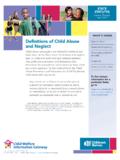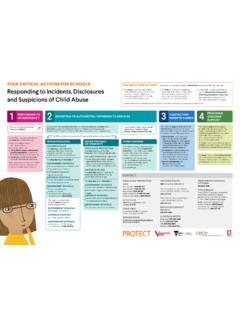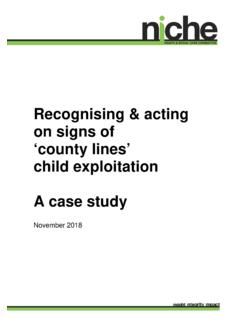Transcription of CHILD PROTECTION PROCEDURE - Early Years
1 1 CHILD PROTECTION PROCEDURE Policy Hierarchy link Children (Education and Care Services National Law Application) Act 2010 Education and Care Services National Regulations 2011 CHILD & Young Persons (Care & PROTECTION ) Act, 1998 Ombudsman Amendment ( CHILD PROTECTION and Community Services) Act, 1998 Commission for Children and Young People Act, 1998 CHILD PROTECTION Act chapter 16A October 2009) CHILD PROTECTION (Prohibited Employment) Act, 1998 CHILD PROTECTION (Working With Children) Regulation 2013 Responsible Officer Vice-President, Campus Life and Community Engagement Contact Officer General Manager 9385 1708 Superseded Documents File Number Contact the Records & Archives Office. Associated Documents Working with Children Check Guidelines, Commission for Children and Young People, 2000 Version Authorised by Approval Date Effective Date Early Years Management November 2016 November 2016 1.
2 Purpose and Scope This PROCEDURE will apply to all families, staff ( full-time/part-time employed staff, casual staff), volunteers, students, visitors, contractors and Management of UNSW Early Years . The principal activity of any CHILD care service is to provide care, education and a safe environment for children. CHILD abuse is a widespread problem and has no cultural or socio-economic boundaries. UNSW Early Years has a responsibility to both children and their families to ensure that children, whilst in our care, are protected from CHILD abuse . Under relevant legislation CHILD care centres are required to ensure allegations of CHILD abuse , concerning children in their care, are appropriately addressed. Numerous procedures are in place to identify and exclude all inappropriate persons from having contact with the children in care as well from being employed at Early Years .
3 This PROCEDURE was developed to provide a framework for the PROTECTION of the CHILD . It is also to clarify procedures for staff who may be required to report on allegations of CHILD abuse . It sets down procedures that relate to allegations of abuse against a staff member or other adult on the services premises or by a staff member generally. The goal of this PROCEDURE is to: promote the safety and wellbeing of all children, and educators attending Early Years provide an environment for the children that is safe, free from neglect and from physical, emotional or sexual abuse by staff or other adults whilst at the Centre ensure that record keeping is sufficiently detailed 2 ensure that staff are trained and skilled in identifying possible indicators of abuse and that they are aware that they are Mandatory Reporters and required to notify any concern or CHILD PROTECTION issue to relevant authorities ensure staff keep up to date on legislation ensure staff are aware of their roles and responsibilities and procedures to follow if a case of abuse or neglect is suspected work within the guidelines and follow ChildStory Reporter Community practices which focus on shared responsibility of CHILD PROTECTION for Non-Government Organisations (NGO)
4 In conjunction with the NSW Department of Education support families at a local level in a co-ordinated approach with other government organisations and NGOs by acting as a network service/agency in recommending appropriate and relevant services in the community for help and support. ensure that all notifications remain confidential 2. Definitions CHILD - A person under the age of 16 Years . CHILD abuse - refers to a CHILD at risk of significant harm . This includes one or more of the following circumstances: the CHILD s basic physical or psychological needs are not being met necessary medical care has not been arranged for the CHILD the CHILD has been or is at risk of being, physically or sexually abused or ill-treated the CHILD is living in a household where domestic violence occurs and, as a consequence, the CHILD is at risk of serious physical and psychological harm a parent or caregiver has behaved in such a way towards the CHILD that the CHILD has suffered or is at risk of suffering serious psychological harm assault (including sexual assault) of a CHILD ill- treatment or neglect of a CHILD exposure or subjecting a CHILD to behaviour that psychologically harms a CHILD .
5 A CHILD abuse allegation can also include an allegation of misconduct that may involve CHILD abuse eg. an allegation involving possession of CHILD pornography. CHILD abuse Conviction - Any conviction of a person, in the State of New South Wales or elsewhere, of an offence involving CHILD abuse , and including a finding by the court that a charge for such an offence is proven even though the Court does not proceed to a conviction. The term allegation must refer to a description of behaviour that may constitute CHILD abuse and also refers to conviction for the purpose of this PROCEDURE . Prohibited person convicted of a serious sex offence will not be permitted to work or seek work in employment which primarily involves direct contact with children where that contact is un-supervised (in either a paid or unpaid role).
6 Vexatious complaint - An allegation of CHILD abuse against another that is unfounded. 3 3. Procedures PART A: Reporting suspected Risk of Harm If there is an immediate danger to the CHILD , the local police station and/or the CHILD PROTECTION Helpline should be contacted immediately. Step 1 Raise the matter in confidence with the Responsible Person and General Manager immediately. A written observation, including the date and full name of CHILD , identifying the concern/ incident must be documented immediately and be based on: first hand observation of the CHILD , young person or family what the CHILD , young person, parent or other person has disclosed what can reasonably be inferred based on professional training and/or experience Have written observations of the CHILD available for discussion Step 2 Access the Mandatory Reporter Guide (MRG) ( ) to see if the CHILD is at Risk of Significant Harm.
7 Print out the decision report Retain report in the CHILD s confidential file. Step 3 a) If MRG informs CHILD is AT RISK of SIGNIFICANT HARM Mandatory Reporter must make a report directly via the ChildStory Reporter site or via the CHILD PROTECTION Helpline on 132 111 OR Step 3 b) If MRG informs the CHILD is NOT at Risk of Significant Harm Continue to record clear, dated, objective observations. Maintain documentation in a confidential file Discussed with the Nominated Supervisor before filing. Work closely to support the CHILD and family. OR Step 3 c) If MRG informs CHILD is NOT at Risk of Significant harm BUT staff remain concerned contact the CHILD PROTECTION Helpline on 132 111 to seek further advice. If required, staff may contact a CHILD s doctor, paediatrician or prior Early childhood centre to seek further assistance under the CHILD PROTECTION Act (Chapter 16A).
8 Step 4) Notify NSW DEPARTMENT OF EDUCATION PART B: When a CHILD makes a disclosure Follow procedures above AND Remain calm and objective and Comfort the CHILD Listen to and believe the CHILD Don t make promises that you cannot keep Convey messages that it is not their fault and it was right to tell Tell them you will need to talk to other people whose job it is to help keep children safe 4 Report to the Responsible Person, General Manager as soon as possible that same day. If a CHILD makes a disclosure in a group situation, calmly follow through on issues discussed with all children regarding protective behaviours. As soon as possible without removing the CHILD from the group inappropriately, move to a quiet area and follow the steps outlined above.
9 Note that our role is to support the wellbeing of the CHILD , not to investigate the disclosure. Do not question the CHILD about the details of the abuse /neglect as legal proceedings may be jeopardised. PART C: Responding to an allegation of abuse by an adult at the centre. An allegation of CHILD abuse may be made against a staff member, student or visitor by another employee, by a CHILD 's parents, or other caregiver, or may arise from advice received by an investigative agency including the Department of Education, the Police Service and/or the Ombudsman. All steps must be carried out regardless of whether the allegations are found to be true or where the incident(s) occurred. Step 1 Complete all steps as per Part A: Steps 1-3. Step 2 Inform the Responsible Person on Duty and UNSW Early Years General Manager immediately.
10 Step 3 Determine whether or not the allegation is a reportable allegation, a reportable conviction, or reportable conduct. Refer to: Step 4 The General Manager, Early Years will inform the UNSW Legal Department. Step 5 Make a report to the Police if deemed appropriate Step 6 Notify the NSW Regulators Department of Education through the National Quality Agenda IT System (NQAITS) using form SI01 Notification of Serious Incident form if Police have been informed OR using form NL01 Notification of Complaints and Incidents (other than serious incidents) form if Police are not informed. Submit to the Department of Education within 7 days of the incident. Step 7 Notify the Ombudsman (9286 1000) and complete CHILD PROTECTION Notification form found at within 30 days Step 8 Notify NSW Family and Community Services (132 111).






